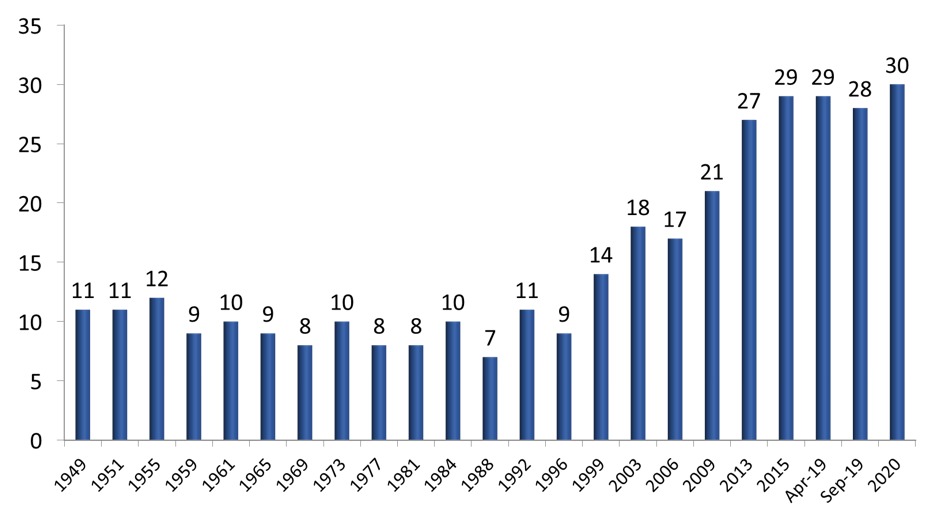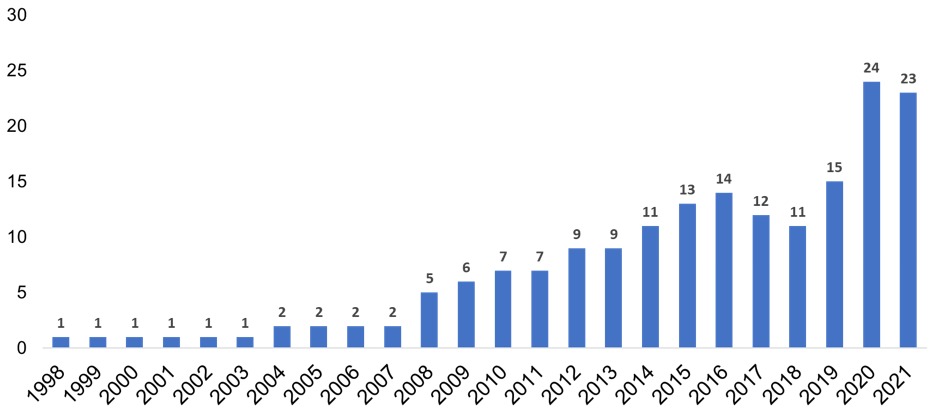Women's Representation in Israeli Politics
Dr. Ofer Kenig weighs in on whether the trend toward greater representation of women in the Knesset has come to a standstill and do Israeli governments suffer from high levels of gender inequality

Has the trend toward greater representation of women in the Knesset come to a standstill? Do Israeli governments suffer from high levels of gender inequality? How many women have served as Israel’s Minister of Finance? And are more and more women around the world reaching the highest political position in their country? This article provides a comparative analysis to mark International Women’s Day.
The issue of women's representation in politics has been the focus of intensive public debate in many countries over the last two decades. The basic premise of this debate is that significant representation of women in political roles is of great importance. Women's presence in the public arena is perceived as positive and indeed—essential—in the context of basic democratic values such as equality and pluralism. Furthermore, such a presence bolsters women’s status in society and the internalization of the fact that women must be citizens of equal value. However, this discussion plays out against the backdrop of a reality in which, in many countries, women are still very much under-represented in political roles. This gap has led numerous countries and political parties to take active steps to enhance women's representation in politics. Thus, several states have instituted gender quotas which have led to a consistent and significant increase in women's representation in parliament. Recently, there has even been an increase in the number of gender-balanced cabinets—those with an even number of men and women serving as ministers. There have also been more cases of women reaching the highest political position, of Prime Minister or President (depending on the system of government).
Women at the Top
The number of women who have reached the highest political position in their country (Prime Minister or President) has grown significantly over the last decade. At the time of this writing, women serve as leaders of eight out of the 37 OECD countries. These include Angela Merkel (Germany), Erna Solberg (Norway), Jacinda Ardern (New Zealand), and Mette Frederiksen (Denmark). As clearly shown in Table 1, since 2012, women have served in these positions in more than half the OECD countries. This list includes countries in which the glass ceiling was smashed for the first time during this period (Germany, Belgium, Austria), as well as countries in which women had already held this role (United Kingdom, Canada, New Zealand).
In 15 of the 37 OECD countries, women have never been appointed to the highest political position. The United States is one of these, though the recent election of Kamala Harris as the country’s first woman Vice President is an important milestone. Israel was one of the first countries in which a woman filled such a position. When Golda Meir was elected Prime Minister in 1969 she was only the third woman in the world to reach such a position. However, since she left the post in 1974, Israel has had eight men Prime Ministers, and not a single woman.
Table 1. Most Recent Year in which a Woman Held the Most Senior Political Position* in the 37 OECD member countries
| Country | Name | Year | Never |
| Estonia | Kaja Kallas | Incumbent | Colombia |
| Lithuania | Ingrida Šimonytė | Incumbent | Czech Republic |
| Finland | Sanna Marin | Incumbent | France |
| Denmark | Mette Frederiksen | Incumbent | Greece |
| Iceland | Katrín Jakobsdóttir | Incumbent | Hungary |
| New Zealand | Jacinda Ardern | Incumbent | Ireland |
| Norway | Erna Solberg | Incumbent | Italy |
| Germany | Angela Merkel | Incumbent | Japan |
| Switzerland | Simonetta Sommaruga | 2020 | Luxembourg |
| Belgium | Sophie Wilmès | 2020 | Mexico |
| Austria | Brigitte Bierlein | 2020 | Netherlands |
| UK | Theresa May | 2019 | Spain |
| Chile | Michelle Bachelet | 2018 | Sweden |
| Poland | Beata Szydło | 2017 | Turkey |
| South Korea | Park Geun-hye | 2016 | United States |
| Latvia | Laimdota Straujuma | 2016 | |
| Slovenia | Alenka Bratušek | 2014 | |
| Australia | Julia Gillard | 2013 | |
| Slovakia | Iveta Radičová | 2012 | |
| Canada | Kim Campbell | 1993 | |
| Portugal | Maria Pintasilgo | 1980 | |
| Israel | Golda Meir | 1974 |
* Prime Minister, or President in presidential democracies (ceremonial presidencies are not included in this list)
Women in Government
Until 1974, the only woman who had served as a minister in Israel’s governments was Golda Meir. With this exception, the government had always been entirely male. The next female ministers were Shulamit Aloni (1974), Sarah Doron (1983), Shoshana Arbeli-Almozlino (1986), and Ora Namir (1992). But by 1996, there were still only five women who had served in the government.
Since then, the situation has improved somewhat, and an additional 19 women have been appointed to ministerial positions. However, at the present time, out of 267 ministers to have served in Israeli governments over the years, only 24 have been women—less than 9%.
Israel’s 35th government—the bloated unity government created after the 2020 elections—included a record number of eight female ministers when it was formed,The subsequent departure of Tzipi Hotovely to serve as Israel’s ambassador to the United Kingdom and the resignation of Meirav Cohen reduced the number of women currently in the government to six. twice as many as the previous record of four women serving in the government.
However, this improvement in female representation in government is no cause for celebration. First, none of these women was appointed to head one of the more prestigious ministries--- Finance, Defense, or Foreign Affairs. The last woman to serve as Foreign Minister was Tzipi Livni (2006–2009), and no woman has ever served as Defense Minister or Finance Minister. Of the six women currently serving in the government, only two were appointed to major ministries: Gila Gamliel to the Ministry of Environmental Protection, and Miri Regev to the Ministry of Transport. The other four were given minor, and even marginal, ministerial positions.
Second, having so few women in the government stands in stark contrast to the trend in many democracies, in which women's representation in government has risen significantly and where there have been more and more cases of cabinets with an even gender balance, or very close to it. As can be seen from Figure 1, Finland, Sweden, Austria, and Spain currently have governments with a female majority, while the governments in Canada and the Netherlands have an almost even number of male and female ministers. There has also been a significant improvement in this regard in the United States. A year ago, women constituted just 13% of the members of Donald Trump’s cabinet. Today, this figure has risen sharply to 38% in the cabinet of the newly elected Joe Biden, including the first woman to hold the position of Vice President and the first woman to serve as Secretary of the Treasury (Janet Yellen). In Israel, by contrast, the percentage of female ministers is just 22%, at six out of 27.
Figure 1. Gender Distribution of Cabinets, February 2021 (%)

Women in Parliament
In Israel’s first three parliamentary elections (1949–1955), women constituted around 10% of those elected to the Knesset (see Figure 2). Subsequently, over the four decades up to 1999, the number of female Knesset members dropped, and ranged between a low of seven (1988) and a high of 11 (1992). Between 1999 and 2015, there was a steep rise in the number of women in the Knesset, but this has tailed off since the 2015 elections. In the last four elections, the number of women elected to the Knesset has been between 28 and 30, around one-quarter of the total of 120 members.
Figure 2. Number of Women in Knesset at the Time of its Election: 1949–2020

A comparison between women's representation in the Knesset and in parallel legislatures in other countries, reveals that (as of the beginning of 2021) Israel ranks 72nd out of 190 countries. If we focus only on the 37 OECD nations, we find that Israel comes in 26th. The rise in women's representation in the Knesset is not a unique phenomenon. In fact, the steep rise in the number of women elected to parliaments around the world has been one of the most striking political developments of the last two decades, and not only in democratic countries. For example, until 2003 there was only one country in the world in which women constituted more than 40% of members of parliament. Today, there are 23 such countries (see Figure 3).
Figure 3 States with at Least 40% Female Representation in Parliament (up to January 2021) *

* Data relates to single house of representatives or to lower house
